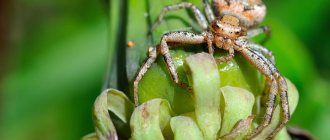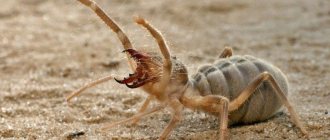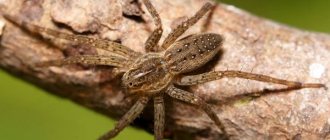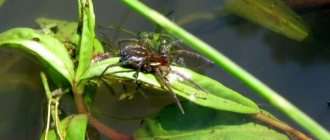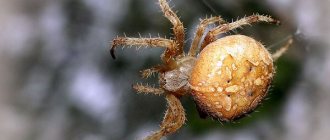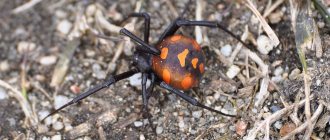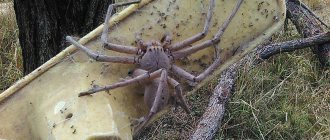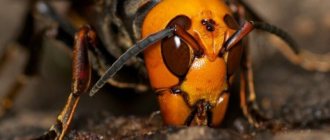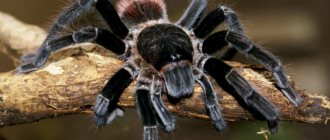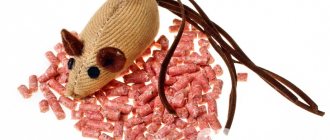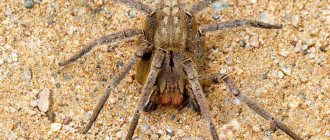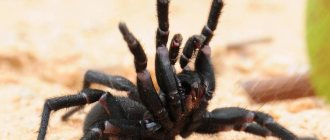You can meet the side-walking spider in any part of Europe. They move exclusively sideways, which is why they got their name. It won’t be easy to see them - thanks to their colors, they are like chameleons able to blend into their environment. They prefer to live among flowering grasses, which allows them to catch butterflies, flies and bees that make up the diet of these spiders. Depending on the weather, they can change their place of residence. During the rainy season, they prefer to seek shelter under the wide leaves of plants.
Body structure and coloring
Females are twice the size of males and can reach a length of 1-1.2 cm. Modified forelimbs allow spiders to move quickly and instantly pull food into their “embraces.” The color of these amazing creatures comes in almost all shades - white, pink, lemon, brown, green, red. The brightest representatives of this species live inside flower buds. Darker ones, with spots and patterns, live on the bark of trees and the ground. The white sidewalk spider is able to merge with the petals, as it has not only a milky body, but also eyes of the same shade.
Poisonous yellow spider
Yellow sak.
Another yellow spider is often found in Russia - the sak. This representative of the animal world is poisonous. But it’s difficult to confuse them - they are radically different.
Yellow sak has more of a beige or flesh tone, not as piercing neon. He prefers to settle in secluded places. Although it bites painfully, its activities are useful to people. Heiracanthium eats a large number of pests.
Peculiarities
Sidewalk spiders do not spin webs to catch flying insects. Female spiders make sacs from this sticky substance into which they lay their eggs. They also use webs to descend from taller plants to lower ones. But the most amazing thing is that with the onset of autumn they use it as a means of transport. Having ridden the bags, they are able to go on a long journey with the first gust of wind. In warm and dry weather, they cover a distance of several kilometers. Sometimes you can see a whole family of spiders on one web. To stop at a place they like, they simply shoot a web onto the nearest tree or plant.
Nutrition
Despite their body size, these arthropods are predators. They do not weave spider webs to catch prey. They only need the web for comfortable movement.
Small predators blend into their environment, waiting for their prey. They can remain absolutely motionless for a long time. They attack not only small insects - they also prey on those whose size is larger than the hunter.
During an ambush, cunning predators camouflage themselves, spread their forelimbs wide, preparing to attack instantly. If there is prey nearby, the arthropod approaches the victim and injects poison.
Toxic substances affect the victim’s nervous system, immobilizing it for a long time . This aggressive behavior is explained by the fact that the spider's front legs are equipped with claws, which contain a powerful poison that paralyzes prey.
When the victim is immobilized, the arthropod sucks all the vital juices out of it. Due to its weak jaw and small size, the sidewalker does not absorb its food entirely. Bumblebees, locusts, bees, and flies serve as food.
Hunter Tactics
Despite their size, spiders are not afraid to attack larger insects. Like real hunters, they can sit in ambush for a long time, waiting for prey with open paws. As soon as a butterfly or wasp lands on a flower, they instantly grab them and bite them in vulnerable places. Having injected the poison, the flower spider begins to eat. However, if a hunter has not eaten for a long time, then his behavior changes radically. He runs restlessly through the leaves, looking for prey and moving his paws in anticipation of lunch. At the sight of an approaching insect, the spider freezes with its legs wide open. From the outside it seems that he opened friendly arms. Thanks to their coloring, they manage to remain unnoticed, and the tactic brings the desired result.
Appearance
The length of an adult female reaches up to 10 mm, and the male is only 3 - 5 mm. On the front part of the muzzle there are paired organs (Chelicera) no more than 0.3 mm in length, at their ends there are poisonous spines with which it digs into the body of the victim and sprays a poisonous venom that causes instant paralysis.
The pedipalps are located next to the chelicerae. They resemble a pair of hands with which he holds food while eating it; males also have genitals at their ends. They serve for him to transfer sperm to the female.
Different types of spiders can have different colors
, here are just a few that we would like to focus on:
- light;
- greenish;
- yellowish;
- less often, intense tones;
Note! That its color can change dramatically depending on the flower on which it is going to ambush in order to catch the victim.
Reproduction
In early June, the mating season begins for sidewalk spiders. Males, like real gentlemen, court the female. If she considers the candidate worthy, then mating occurs. After a short break, the procedure is repeated, and after a while the female attaches cocoons wrapped in a web to the back of the leaves. Although this species does not tend to live surrounded by relatives, there are cases when a whole family of spiders lives on one plant.
Is yellow sak good for you?
Despite the fact that the yellow saka is dangerous to humans, it is considered a useful predator, as the spider kills more than 2,000 harmful larvae and insects per year, thereby helping people fight parasites.
Sources
- Guide to Medical Entomology / ed. V.P. Derbeneva-Ukhova. – M.: Medicine, 1974 – 359 p.
- Yatusevich, A.I. Little-studied infectious and parasitic diseases of domestic animals: textbook / A.I. Yatusevich, N.N. Androsik. – Minsk: Urajai, 2001 – 331 p.
- Parasitology and invasive diseases of farm animals / K.I. Abuladze [and others]. – M.: Agropromizdat, 1990 – 464 p.
- Workshop on parasitology and invasive animal diseases: textbook / A.I. Yatusevich [and others]. – Minsk: Urajai, 1999 – 279 p.
- Kapustin, V.F. Atlas of blood parasites of animals and exidid mites / V.F. Kapustin. – M.: State and agricultural literature, 1955 – 216 p.
- Diagnosis, therapy and prevention of parasitic diseases of horses. UMP for veterinary students and FPC students. / A.I. Yatusevich, S.I. Stasyukevich, M.P. Sinyakov, V.V. Petrukovich. / Vitebsk, VGAVM, 2011. 60 p.
- Bulanova-Zakhvatkina, E.M. Oribatid oribatid mites / E.M. Bulanova-Zakhvatkina. – M.: Higher School, 1967 – 254 p.
- Yatusevich, A.I. Eimeriosis of chickens and its parasitocenological aspects / A.I. Yatusevich, A.V. Sandul, V.N. Gisco. – Vitebsk: VGAVM, 2009 – 249 p.
- Parasitology and invasive diseases of farm animals / K.I. Abuladze, N.V. Demidov, A.A. Napoklonov and others; And. K.I. Abuladze. – 3rd ed. – M.: Agropromizdat, 1990 – 464 p.
- Balashov, Yu. S. Blood-sucking ticks (Ixodoidea) - carriers of human and animal diseases / Yu. S. Balashov. – L.: Nauka, 1967 – 320 p.
- Determinant of helminths of hunting mammals in Belarus: monograph / A. I. Yatusevich [et al.]. – Vitebsk: VGAVM, 2010 – 228 p.
- Veterinary and sanitary measures for the prevention and elimination of parasitic diseases of animals: methodological recommendations / I. N. Dubina [et al.]. – Vitebsk: VGAVM, 2008 – 51 p.
- Dubina I. N. Veterinary and sanitary standards for the prevention and elimination of cestodiasis in animals: approved. GUV MAHIP RB / I.N. Dubina, A.I. Yatusevich. – Vitebsk: VGAVM, 2007 – 10 p.
- Yatusevich A.I., Parasitic diseases of birds / A.I. Yatusevich, B.Ya. Birmansky, T.G. Nikulin. – Minsk: Publishing house “Polybig”, 2001.
- Olenev, N.O. Scabies mite / N.O. Olenev. - Gone. Academician Science of the USSR, 1932. – 64 p.
- Kuznetsov, M.I. Anoplocephalatosis of ruminants / M.I. Kuznetsov. – M.: Kolos, 1972.
- Stepanova, N.I. Protozoal diseases of animals / N.I. Stepanov. – M.-L.: Kolos, 1982.
- Processes of adaptation and parasitosis of animals: monograph / A.I. Yatusevich [and others]. – Vitebsk: Educational Institution VGAVM, 2006 – 404 p.
- Yatusevich A.I., Poorly studied infectious and invasive diseases of domestic animals / A.I. Yatusevich, N.N. Androsik. – Minsk: Urajai, 2001 – 332 p.
- Dubinina, M.N. Parasitological studies of birds / M.N. Dubinin. – L.: Nauka, 1971. – 139 p.
- Savchenko, S.V. Prevention and treatment of esophagostomal invasion of balantidiasis in pigs / S.V. Savchenko, V.F. Savchenko. – Vitebsk: VGAVM, 2010 – 194 p.
- Theoretical and practical basis for the use of medicinal plants for parasitic diseases of animals / A.I. Yatusevich [and others]. – Vitebsk: VGAVM, 2008 – 75 p.
- Dubinin, V.B. Scabies mites. Biology, harm in agriculture, prevention and control measures / V.B. Dubinin. -M.: Soviet Science, 1954. – 173 p.
- Yatusevich, A.I. Arachnoenthomosis of domestic ruminants and ungulates: monograph / A.I. Yatusevich [and others]. – Vitebsk: VGAVM, 2006 – 213 p.
- Subbotin, A. M. Boar sparganosis: differential diagnosis and improvement of measures to combat it in the conditions of the Republic of Belarus: teaching methods / A. M. Subbotin, N. F. Karasev, V. F. Litvinov. – Vitebsk: VGAVM, 2009 – 24 p.
- Yatusevich, A.I. Aymerosis of nutria: monograph / A.I. Yatusevich, V.A. Forget about it. – Vitebsk: OU VGAVM, 2006 – 87 p.
- Parasitology and invasive animal diseases / M.Sh. Akbaev [and others]. – M.: Kolos, 2000. – 743 p.
- Yatusevich, A.I. The Pratazoins lived in a trapped rural population. – Minsk: Urajai, 1993 – 174 p.
- Animal cryptosporidiosis (Recommendations for diagnosis, therapy and prevention). Approved by the Ministry of Agriculture of the State Administration and Administration of the Republic of Belarus on July 25, 2000 Authors: Yatusevich A.I., Savchenko V.F., Nesterovich S.G. et al.
- Balashov, Yu. S. Blood-sucking arthropods and rickettsia / Yu. S. Balashov, A.B. Daiter. – L.: Nauka, 1973 – 251 p.
- Parasitology and invasive animal diseases / M.Sh. Ak-baev, A.A. Vodyanov, N.E. Kosminkov and others; And. M. Sh. Akbaeva. – M.: Kolos, 2002 – 743 p.
- Recommendations for the fight against helminthiasis in horses / A.I. Yatusevich [and others]. – Vitebsk: VGAVM, 2008 – 15 p.
- Dubinin, V.B. Scabies mites. Biology, harm in agriculture, prevention and control measures / V.B. Dubinin. -M.: Soviet Science, 1954. – 173 p.
- Agrinsky, N.I. Insects and mites that harm farm animals / N.I. Agrinsky. – M.: Selkhozizdat, 1962 – 288 p.
- Sokolova, T.V. Shchesotka / T.V. Sokolova, R.F. Fedorovskaya, A.B. Lange. – M.: Medicine, 1989 – 176 p.
- Yatusevich, A.I. Veterinary and medical parasitology: (Encyclopedic reference book) / A.I. Yatusevich, I.V. Rachkovskaya, V.M. Kaplich. – M.: Medical literature, 2001 – 309 p.
- Yatusevich, A.I. Eimeriosis of chickens: monograph / A.I. Yatusevich, V.N. Gisco. – Vitebsk: OU VGAVM, 2007 – 103 p.
- Karasev, N.F. Larval cestodosis of animals / N.F. Karasev, T.G. Nikulin, N.K. Slepnev. – Minsk: Urajai, 1989 – 111 p.
- Kapustin, V.F. Atlas of helminths of farm animals. – M.: Selkhozgiz, 1953. – 139 p.
- Dubina I. N. Guidelines for the diagnosis of carnivorous helminthiases: approved. GUV MAHIP RB / IN Dubina. – Vitebsk: VGAVM, 2008 – 32 p.
- Yatusevich, A.I. Helminth infections of cattle and measures to combat them under environmental stress / A.I. Yatusevich, R.N. Protasovitskaya. – Vitebsk: VGAVM, 2010 – 160 p.
- Veterinary laboratory practice. T. 2. – M.: Selkhozizdat, 1963. – 432 p.
- _https://domvred.ru/zheltyj-pauk-sak-xejrakantium/
- Orlov, I.V. Workshop on veterinary parasitology / I.V. Orlov, N.I. Agrinsky, S.N. Nikolsky. – M.: Selkhozizdat, 1962 – 319 p.
- Practical parasitology / ed. D. V. Vinogradov-Volzhinsky. – L.: Medicine, 1977 – 304 p.
- Antiparasitic drugs for dogs and cats: compensation for damage / AI Textbook Yatusevich [et al.]. – Vitebsk: VGAVM, 2009 – 48 p.
- Shershen, G.G. Methodological recommendations for identifying natural foci of piroplasmosis in animals in Belarus / G.G. Shershen, N.F. Karasev. – Vitebsk: VGAVM, 2009 – 32 p.
- Midges and simulidotoxicosis in cattle. / Skulovets M.V. / -2007
- Parasitic diseases of horses / A.I. Yatusevich [and others]. – Minsk, 1999 – 78 p.
- Kaplich, V. M. Vile and measures to combat it in Belarus / V. M. Kaplich, A. I. Yatusevich, M. V. Skulovets. – Minsk: Urajai, 1994 – 120 p.
- Dubina, I.N. Guidelines for the diagnosis of larval cestodiasis in animals / I.N. Club. – Vitebsk: VGAVM, 2008 – 39 p.
- Diseases of agricultural animals / P.A. Krasochko [and others]; edited by DAD. Beautiful. – Minsk: Businessofset, 2005 – 800 p.
[/spoiler]
Is it dangerous for humans?
The venom of this predator is very toxic and can instantly paralyze the victim. But fortunately for man, his concentration is not strong enough. Contrary to popular belief, representatives of this species, which are brightly colored, do not themselves attack people. They sense danger very well and will not take risks, knowing that they will lose this battle. Don't be afraid if a spider bites a pet - your pet most likely won't even notice. But smaller representatives of the fauna may feel a slight malaise and disorientation. Mice, rats, hamsters and other rodents should not be kept near sidewalk spiders.
Recommendations for a bite
Sidewalkers rarely attack humans. Their bites are not particularly dangerous, but they cause discomfort.
Symptoms of a sideworm bite:
- slight red swelling of the affected area;
- itching and burning;
- pain in the head, malaise, dizziness;
- general weakness.
For treatment, it is recommended to use ice by placing it on the affected area. Antihistamines will come to the rescue. The bite area is treated with “Asterisk” ointment. It should be remembered that this species has poisonous glands.
Keeping at home
This animal can make an excellent pet. They are unpretentious in food and do not require much space. The terrarium must be at least 40 cm long and 30 cm wide. Particular attention should be paid to humidity - the sidewalk spider will die if it ends up in a dry, closed container. The temperature should be within 20 degrees. For food, you need to select insects that are no larger than the size of a spider. Flies, cockroaches, and crickets are ideal. With proper care, spiders live 2-3 years.
Spreading
The flower spider is widespread in North America and Eurasia. Its range on the American continent extends from Alaska to the southern borders of the United States, and in Europe from Iceland and Scandinavia to the Mediterranean coast.
Presumably the American population descends from spiders brought by European settlers. In Asia, clubfoot mizumena live in the temperate zone from southern Russia to Japan.
They inhabit sunlit meadows, fields and forest edges. In urban areas, gardens and parks are used, and places that are too wet and shady are strictly avoided.
Interesting facts about sidewalkers
- Some species have the ability to slowly change their color.
- Before mating, the male brings his lady a gift in the form of an edible insect.
- Some people specifically bring home cockroaches to get rid of cockroaches.
- Spiders are able to distinguish the sounds of music and even “dance.”
- They distinguish relatives at a distance of up to 5 meters.
- Because of their style of moving sideways, they are called crab spiders.
- Some species hunt exclusively at night, waiting for moths inside a flower.
- They do not attack insects that are much smaller in size than the spider’s body.
- Farmers move sidewalkers to their fields to get rid of pests.
- Due to the small size of the fangs, they are not able to bite through human skin.
Lifestyle
Wasp spiders live alone or in small groups, the maximum colony size is up to 20 arthropods. They belong to the category of predatory spiders; their favorite diet is grasshoppers, dragonflies, and flies. Sometimes bees and wasps get caught in the snare, but then the battle flares up to the point of life and death. The unlucky hunter dies from bee (wasp) venom.
At dusk, a spider with yellow stripes on its back weaves trapping nets. He spreads a radial net, deftly connecting plant stems with spiral threads. A special “decor” is woven in the center or at the bottom of the web - stabilimentum - a thickened zigzag thread. Scientists interpret the purpose of this “pattern” differently - for camouflage, attracting prey, as a sign to relatives that the territory is occupied.
Interesting! The wasp spider is one of the fastest weavers. It creates a circular network with a radius of up to half a meter in 40–60 minutes.
After the work, the argiope sits on the stabilimentum and patiently waits for prey. The spider sprays poison into the victim, which paralyzes and turns the insides into a liquid mass. It is this “broth” that the predator sucks out, leaving only the chitinous shell of the insect. To maintain vital activity, the spider needs one successful hunt per week.
Karakurt
Knowledgeable people say that this white spider is dangerous to humans. Its venom is not as strong as that of its black counterpart, but for a child, old man or weakened patient, the bite can be fatal.
Look carefully at the photo of the karakurt and try to remember it. This spider does not have an “hourglass” on its back, like its relative, but you can recognize it by the presence of four recessed points on its back. The head and abdomen of this species are usually yellowish.
You can meet this spider in some regions of Kazakhstan, Turkmenistan, Azerbaijan, in the south of Russia, in some countries of Africa and the Middle East. If you see this creature, try not to disturb its peace and remember: spiders are not interested in people, they are afraid of them and will never attack first. But if, through negligence, you touch a spider and it responds aggressively, the victim should immediately consult a doctor.
Varieties
Sidewalk spiders are terrestrial animals. They are found everywhere on the globe. In warm climates, species diversity is much wider than in temperate and cold climates.
Spiders adapt to climatic conditions in various ways. One of them is coloring. All varieties of bocod spiders have their own shade. This family has 170 genera, in which about 2000 species are distinguished. The most studied types are:
Flower spider (Misutnena vatia)
- color white, yellowish;
- body size up to 11 mm;
- lives on flowers of the ranunculaceae and cornflower family;
- food: butterflies, bumblebees, bees;
- Habitat: Europe, North America.
Yellow crab spider (Xisticus luctuosus)
- the body of the male is dark brown, 4-5 mm long, the female is yellow – 7-8 mm;
- lives in meadows and forest clearings;
- distributed in the European part of Russia and the former USSR.
Ornamented blueberry (Synaema ornatum)
contrasting color: the bottom of the abdomen is black, the top is red or yellow with a black angular spot;
- body length of a male is 5-6 mm, female – 7-8 mm;
- lives on flowers of the Rosaceae family;
- feeds on insects;
- lives in the steppe and forest-steppe of our country.
White Demon
But the next creature is not to be trifled with. Those who travel to Africa and South America have a chance to meet him. This large black and white spider is characterized by aggressive behavior, and its venom is toxic to humans. It is not a species of Heteroscodra maculata, but its bites are painful and require medical attention. The spider's venom quickly spreads throughout the body and can cause a lot of trouble.
The leg span of this creature reaches 15 cm. Its body is covered with hairs that make it look like a fur toy. But this impression is deceptive - before you is a formidable opponent. Contact with him should be avoided.
Folk signs
Since ancient times, spiders have caused many controversial associations. According to some sources, they were considered the guardians of the house, and according to others, they foreshadowed unexpected guests and even the invasion of enemies. But a white spider has always been considered a harbinger of good things. This even applies to dreams.
Large white spiders seen in a dream are considered to be harbingers of weddings, achievements, job promotions and profits.
To summarize, we can say that even the most dangerous and poisonous species of spiders pose a danger only to those who are eager to grab them in their hands and in every possible way interfere with the quiet life of spiders. But a white creature can only be found in the snow - but they don’t run in the snow.
Caring for all living things helps to avoid many unsafe situations.
Competition “Bio/Mol/Text”-2020/2021
This work was published in the “Own Work” category of the “Bio/Mol/Text” competition - 2020/2021.
The nomination partner is the Russian Science Foundation.
The general partner of the competition is the annual biotechnology conference BiotechClub, organized by the international innovative biotechnology company BIOCAD.
The sponsor of the competition is SkyGen: a leading distributor of life science products on the Russian market.
Competition sponsor: the largest supplier of equipment, reagents and consumables for biological research and production.
"Book" sponsor of the competition - "Alpina Non-Fiction"
White Lady
Of all the white spiders, the lady is the largest - the leg span sometimes reaches 10 cm. This species lives in the hot African Namib Desert. The peculiar climate dictates its conditions; there are relatively few people in those parts. There are practically no cases of this spider attacking humans, so the species is not considered dangerous.
This creature is often called the “dancing spider”, due to its peculiar manner of movement and characteristic tapping. It has been established that with the help of frequent “stomping” spiders communicate with each other: they transmit signals of danger and even proposals to start a family.
This white spider, like many of its relatives, is a predator and feeds on insects. If fate takes you to and you are lucky enough to meet a white lady, try not to scare her. They have excellent hearing, but their eyesight is rather weak. Watch this beauty, trying not to make noise, because it’s not often that you get to see such an unusual creature.
